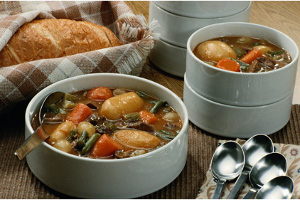Regardless, as the first year of the 2010s draws to a close, it may well be time to look back to the 1990s for inspiration--and not solely for a trip down

|
| Healthy Soups |
memory lane--to the days of dial-up modems and flannel. What were some of the hotter food trends of the decade of grunge? The January 1992 issue of Prepared Foods (randomly picked) had a focus on six such trends: a healthier, 96% fat-free ground beef; competing lines of healthy soups; a line of all-natural baby foods packaged for the microwave; lunch options for the harried office worker; kid-oriented, quick breakfast meals which also incorporated nutritious elements; and the growth potential of Caribbean cuisine.
Admittedly, the market for Caribbean cuisine remains fairly untapped, but a new report, “Culture of Millennials 2011,” from The Hartman Group, suggests the desire for healthy and natural or organic items is as strong as ever. The report contends Millennials (those between 16-30) are beginning to shift their brand preferences away from the brands in their parents’ homes. As this generation leaves home, some 20% “switch almost entirely to different brands, when they move out on their own.” What key food and beverage descriptors are they seeking on products they purchase? Healthy, organic and natural, at least more so than their parents’ choices, and at the same time, more expensive, suggesting this group is not averse to paying for items perceived to be of higher quality.
While the perception of healthy foods may have changed (fat-free has seen a particular dip in popularity), the concept and desire for them remains as strong as ever. It’s just that in the 2010s, consumers have begun to focus on products with nutritional benefits, such as probiotics, added fiber and the like. pf

